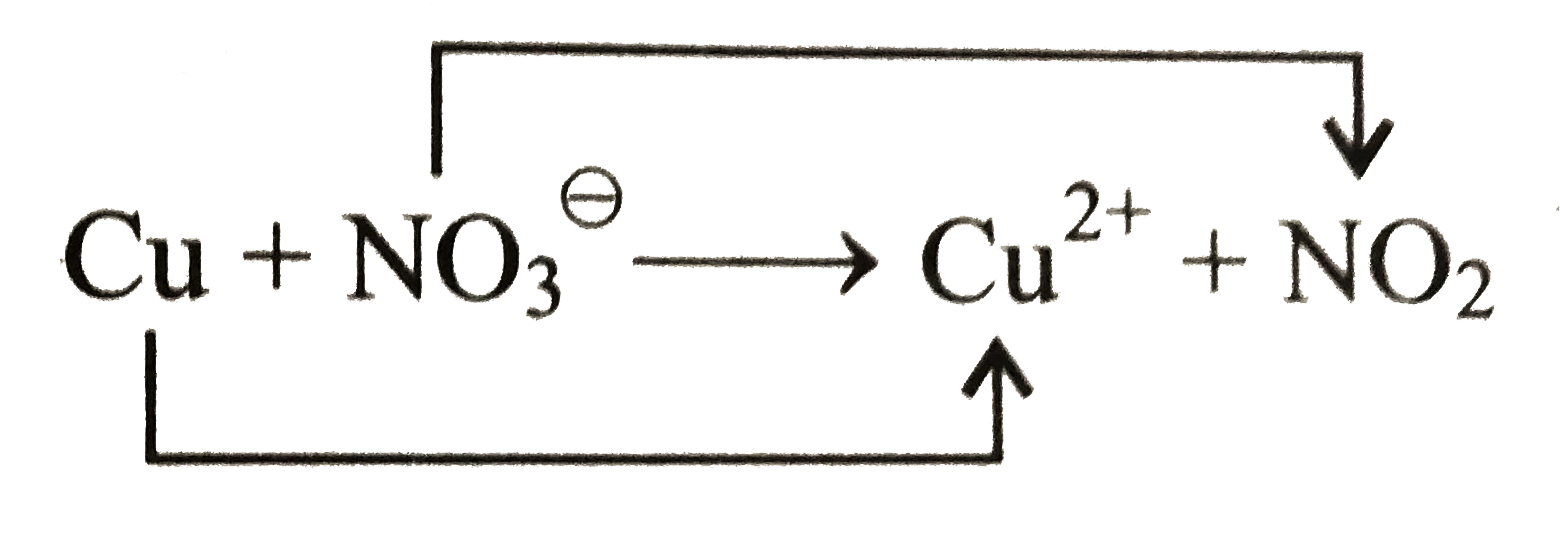Complete Solutions to Solved Examples of chapter REDOX REACTIONS of Class 11 book with complete answers and questions
| Class 11 | CHEMISTRY |
| Chapter | REDOX REACTIONS |
| CENGAGE CHEMISTRY | Solved Examples |
| Number Of Questions | 33 |
| Academic Year | 2023-24 |
Calculate the oxidation number of all the atoms in the following compounds and ions:
a. `PbSO_(4)`, b. `CrO_(4)^(2-)`, c. `Sb_(2)O_(5)`, d. `NH_(4)_(2)SO_(4)`
View SolutionDetermine the oxidation number of following underline elements:
a. `HCulN`
b. `Hul(N)C`
c. `Hul(N)O_(3)`
d. `KulO_(2)`
e. `ul(Fe_(3))O_(4)`
f. `Kul(I_(3))`
g. `ul(N_(3))H`
h. `ul(Fe)(CO)_(5)`
i. `ul(Fe_(0.94))O`
j. `ul(N)H_(2)NH_(2)`
k. `ul(Fe)SO_(4)(NH_(4))_(2)SO_(4)6H_(2)O`
l. `ul(N)OCI`
m. `NOul(Cl)O_(4)`
n. `Na_(2)[ul(Fe)(CN)_(5)NO]`
o. `[ul(Fe)(NO)(H_(2)O)_(5)]SO_(4)`
p. `Na_(ul(2S_(4))O_(6)`
q. `(CH_(3))_(2)ul(SO)`
r. `Naul(S_(2))O_(3)`
s. `CaOul(Cl_(2))`.
View SolutionUsing stock notation, represent the following compounds:
a. `HAuBr_(4)` , b. `Tl_(2)O` , c. `FeO` , d. `Fe_(2)O_(3)`, e. `CuBr`, f. `CuO`
g. `MnO`, h. `MnO_(2)`
View SolutionWhich of the following species do not show disproportionation reaction and why?
`BrO^(ө)` (hypobromirte ion), `BrO_(2)^(ө)` (bromite ion), `BrO_(3)^(ө)`(bromate ion),and `BrO_(4)^(ө)` (perbromate ion)
View SolutionClassify the following redox reactions:
a. `N_(2)(g)+O_(2)(g)rarr 2NO(g)`
b. `2Pb(NO)_(3)(s)rarr2PbO(s)+2NO_(2)(g)+(1)/(2)O_(2)(g)`
c. `NaH(s)H_(2)O(l)rarr NaOH(aq)+H_(2)(g)`
d. `2NO_(2)(g)+2overset(ө)OH(aq)rarrNO_(2)^(ө)(aq)+NO_(3)^(ө)(aq)+H_(2)O(l)`
View SolutionWhy following two reaction proced differently?
`Pb_(3)O_(4)+8HClrarr3PbCl_(2)+Cl_(2)+4H_(2)O`
and
`Pb_(3)O_(4)+4HNO_(3)rarr2Pb(NO_(3))_(2)+PbO_(2)+2H_(2)O`
View SolutionUse the arbitrary method to balance the following equations:
a. `KIO_(3)+KI+H_(2)SO_(4)rarrKI_(3)+K_(2)SO_(4)+H_(2)O`
b. `Pb(N_(3))_(2)+Co(MnO_(4))_(3)rarrCoO+MnO_(2)+Pb_(3)O_(4)+NO`
c. `K_(4)[Fe(CN)_(6)]+KOH+Ce(NO_(3))_(4)rarrFe(OH)_(3)+Ce(OH)_(3)+K_(2)CO_(3)+KNO_(3)+H_(2)O`
View SolutionBalance the following reactions by oxidation number method
`KMnO_(4) + H_(2)SO_(4) +HCl rarr K_(2) SO_(4) + MnSO_(4) + H_(2) O + Cl_(2)`
View SolutionBalance the following reaction by oxidation number method:
`CrO_(4)^(2-)+I^(ө)rarrCr^(3+)+IO_(3)^(ө)` ( in alkaline or basic medium)
View SolutionComplete and balance the following in acidic medium:
`Ag^(o+)+AsH_(3)rarrH_(3)AsO_(3)`
View SolutionBalance the following reaction in acidic medium.
`CuS+NO_(3)^(ө)rarrcu^(2+)+S_(8)=NO`
View SolutionBalance the following by ion electron method is basic medium.
`NO_(3)^(ө)+Znrarr Zn^(2+)+NH_(4)^(oplus)`.
View SolutionBalance the following by ion electron method (acidic medium).
`Mn^(2+)+S_(2)O_(8)^(2-)rarrMnO_(4)^(ө)+HSO_(4)^(ө)`
View SolutionBalance the following by ion electron method in acidic medium.
`CIO_(3)^(ө)+I_(2)rarrIO_(3)+CI^(ө)`
View SolutionWhich of the following are examples of disproportionation reactions?
a. `Ag(NH_(3))_(2)^(o+)+2H^(o+)rarrAg^(o+)+2overset(o+)NH_(4)`
b. `Cl_(2)+2overset(ө)OHrarrClO^(ө)+Cl^(ө)+H_(2)O`
c. `CaCO_(3)rarrCaO+CO_(2)`
c. `CaCO_(3)rarrCaO+CO_(2)`
d. `2HgOrarr2Hg+O_(2)`
e. `Cu_(2)+2H^(o+)rarrCu+Cu^(2+)+H_(2)O`
f. `CuS+O_(2)rarrCu+SO_(2)`
g. `2HCuCl_(2)+"dilute with" H_(2)OrarrCu+Cu^(2+)+4Cl^(ө)+2H^(o+)`
h. `2H_(2)O_(2)rarr2H_(2)O+O_(2)`
View SolutionBalance the following by ion electron method (basic medium):
`Cr(OH)_(3)+IO_(3)^( ө)rarrI^(ө)+CrO_(4)^(2-)`
View Solution`H_(2)SO_(4)` acts as an oxidising agent, a dehydrating agent, and an acid. Among each of the following reactions, which behaviour is shown by `H_(2)SO_(4)`?
a.`C_(6)H_(12)O_(6)+H_(2)SO_(4)(conc)rarr6C+6H_(2)O`
b. `5H_(2)SO_(4)(conc)+4ZnrarrH_(2)S+4Zn^(2+)+4SO_(4)^(2-)+4H_(2)O`
c. `H_(2)SO_(4)(dil)+ZnrarrZn^(2+)+H_(2)+SO_(4)^(2-)`
d. `H_(2)SO_(4)(dil)ZnCO_(3)rarrZn^(2+)+CO_(2)+CO_(2)+SO_(4)^(2-)+H_(2)O`
View SolutionBalance the following reaction by ion electrons method ( acidic medium).
`As_(2)S_(3)-NO_(3)^(ө)rarrS+NO_(2)+AsO_(4)^(3-)`
View SolutionFor the reaction
`3Br_(2)+6OH^(ө)-ltBr^(ө)+BrO_(3)^(ө)+3H_(2)O`
Equivalent weight of `Br_(2)` (molecular weitht M) is
View Solution`P_(4)+3overset(ө)OH+3H_(2)Orarr3H_(2)Orarr3H_(2)PO_(2)^(ө)+PH_(3)`
Equivalent weight of `P_(4)` is
View Solution`3KClO_(3)+3H_(2)SO_(4)rarr3KHSO_(4)+HClO_(4)+2ClO_(2)+H_(2)O`
Equivalent weight of `KClO_(3)` is
View Solution`Cu_(2)S+MnO_(4)^(ө)rarrCu^(2+)+Mn^(2+)+SO_(2)`
The equivalent weight of `Cu_(2)` is
View Solution`As_(2)S_(3)+7NaClO_(3)+12NaOHrarr2Na_(3)AsO_(4)+7NaClO+3Na_(2)SO_(4)+6H_(2)O`
The equivalent weight of `As_(2)S_(3)` is
View SolutionThe equivalent weight of `HNO_(3)` (molecular weight `=63`) in the following reaction is
`3Cu+8HNO_(3)rarr3Cu(NO_(3))_(2)+2NO+4H_(2)O`
View SolutionThe equivalent weight of `H_(2)SO_(4)` in the following reaction is
`Na_(2)Cr_(2)O_(7)+3SO_(2)+H_(2)SO_(4)rarr3Na_(2)SO_(4)+Cr_(2)(SO_(4))_(3)+H_(2)O`
View SolutionThe equivalent weight of potash alum
`(K_(2)SO_(4).Al_(2)(SO_(4))_(3).24H_(2)O)` is
View SolutionCalculate the number of moles of `Cu` and `HNO_(3)` to give `NO` and `NO_(2)` in the `(2:1)` molar ratio.
View SolutionBalance the following equations:
a. `BaCrO_(4) + KI+HClrarrBaCl_(2)+I_(2)+KCl+CrCl_(3)+H_(2)O`
b. `SO_(2)+Na_(2)CrO_(4)+H_(2)SO_(4)rarrNa_(2)SO_(4)+Cr_(2)(SO_(4))_(3)+H_(2)O`
c. `C_(2)H_(5)OH+I_(2)+overset(ө)OHrarrCHI_(3)+HCO_(2)^(ө)+H_(2)O+I^(ө)` (Basic)
d. `As_(2)S_(3)+HNO_(3)rarrH_(3)AsO_(4)+H_(2)SO_(4)+NO`
e. `......+HC_(2)O_(4)^(ө)rarrCO_(3)^(2-)+Cl^(ө)` (Acidic)
f. `HgS+HCl+HNO_(3)rarrH_(2)NO_(3)rarrH_(2)HgCl_(4)+NO+S+H_(2)O`
g. `Mn_(2)O_(7)rarrMnO_(2)+O_(2)`
View SolutionBalance the following equations:
i. `As_(2)S_(3)+NaClO_(3)+NaOHrarrNa_(3)AsO_(4)+NaClO+Na_(2)SO_(4)`
ii. If `M` is the molecular mass of `As_(2)S_(3)`, the equivalent weight of `As_(2)S_(3)` is
a. `M//24` , b. `M` ,c. `M//2` ,d. `M`//28`.
View SolutionWrite a balanced equaiton when copper reacts with nitric acid, a brown gas is fromed and the solution turns blue.

View SolutionBalance the following redox equaiton by both methods.
`[Cr(OH)_(4)]^(ө)+H_(2)O_(2)rarrCrO_(4)^(2-)+H_(2)O`(basic medium)
View SolutionBalance the following reactions:
a. `U(SO_(4))_(2)+KMnO_(4)+H_(2)OrarrH_(2)SO_(4)+K_(2)SO_(4)+MNSO_(4)+UO_(2)SO_(4)`
b. `Bi_(2)O_(3)+NaOH+NaOClrarrNaBiO_(3)+NaCl+H_(2)O`
c. `Ca(Ocl)_(2)+KI+HCIrarrI_(2)+CaCl_(2)+H_(2)O+KCI`
d. `MnO+PbO_(2)+HNO_(3)rarrHMnO_(4)+Pb(NO_(3))_(2)+H_(2)O`
(e) `CeI_(3) + KOH + Cl_(20 rarr K_(2)CrO_(3) + KIO_(4) + Kcl+H_(2)O`
(g) `Na_(2)HasO_(3) + NaI + HCl rarr NaCl + KBr + H_(3)AsO_(4)`
(g) `Na_(2)TeO_(3) + Nal rarr NaCl + Te + H_(2)O+I_(2)`
(h) `K_(3)[Fe(CN)_(6)] + Cr_(2)O_(3) + KOH rarr K_(4)[Fe(CN)_(6)]+K_(2)CrO_(4)+H_(2)O`
(i) `NH_(3)+O_(2) rarr NO + H_(2)O`
(j) `HNO_(3)+HI rarr NO + I_(2) + H_(2)O`
(k) `MnSO_(4)+(NH_(4))_(2)S_(2)O_(8) + H_(2)O rarr MnO_(2) + H_(2)SO_(4)+(NH_(4))_(4)`
(l)`CuO+NH_(3)rarrN_(2)+H_(2)O+Cu`
m. `NaHSO_(4)+Al+NaOHrarrNa_(2)S+Al_(2)O_(3)+H_(2)O`
n. `CoCl_(2)+Na_(2)O_(2)+NaOH+H_(2)OrarrCo(OH)_(3)+NaCl`
o. `[Cu(NH_(3))_(4)]Cl_(2)+KCN+H_(2)rarrNH_(3)+NH_(4)Cl+KCl+KCNO+K_(2)Cu(CN)_(3)`
p. `Sb_(2)O_(3)+KIO_(3)+HCI+H_(2)OrarrHSb(OH)_(6)+KCI+ICI`
q. `WO_(3)+SnCl_(2)+HClrarrW_(3)O_(8)+H_(2)SnCl_(6)+H_(2)O`
r. `CoCl_(2)+KNO_(2)+CIrarrK_(3)Co(CNO_(2))_(6)+NO+KCI+H_(2)O`
s. `V(OH)_(4)Cl+FeCl_(2)+HClrarrVOCl_(2)+FeCl_(2)+FeCl_(3)+H_(2)O`
t. `Ag+KCN+O_(2)+H_(2)OrarrK[Ag(CN)_(2)]+KOH`
u. `KClO_(3)+H_(2)SO_(4)rarrKHSO_(4)+O_(2)+ClO_(2)+H_(2)O`
v. `Cr_(2)O_(3)+Na_(2)CO_(3)+KNO_(3)rarrNa_(2)CrO_(4)+CO_(2)+KNO_(2)`
w. `Au+CN^(ө)+O_(2)rarr[Au(CN)_(4)]^(ө)` (aqueous solution)
x. `Zn+ReO_(4)^(ө)rarrRe^(ө)+Zn^(2+)` (acidic medium)
View SolutionComplete and balance the following equations:
1. `ClO_(2)+O_(2)^(2-)rarrClO_(2)^(Ө)+` ? (Basic medium)
2. `Cl_(2)+IO_(3)^(Ө)rarrIO_(4)^(Ө)+?` (Basic medium)
3. `Cu+NO_(3)^(Ө)+?rarrCu^(2+)+NO_(2)+?`
4. `H_(2)S+K_(2)CrO_(4)+H_(2)SO_(4)rarr?`
5. `Fe^(2+)+MnO_(4)^(Ө)rarrFe^(3+)+Mn^(2+)+?`
6. `Zn+HNO_(3)rarr?+N_(2)O+?`
7. `HI+HNO_(3)rarr?+NO+H_(2)O`
View Solution
Solved Examples questions and complete solutions for chapter REDOX REACTIONS of CENGAGE CHEMISTRY (HINGLISH) of Class 11